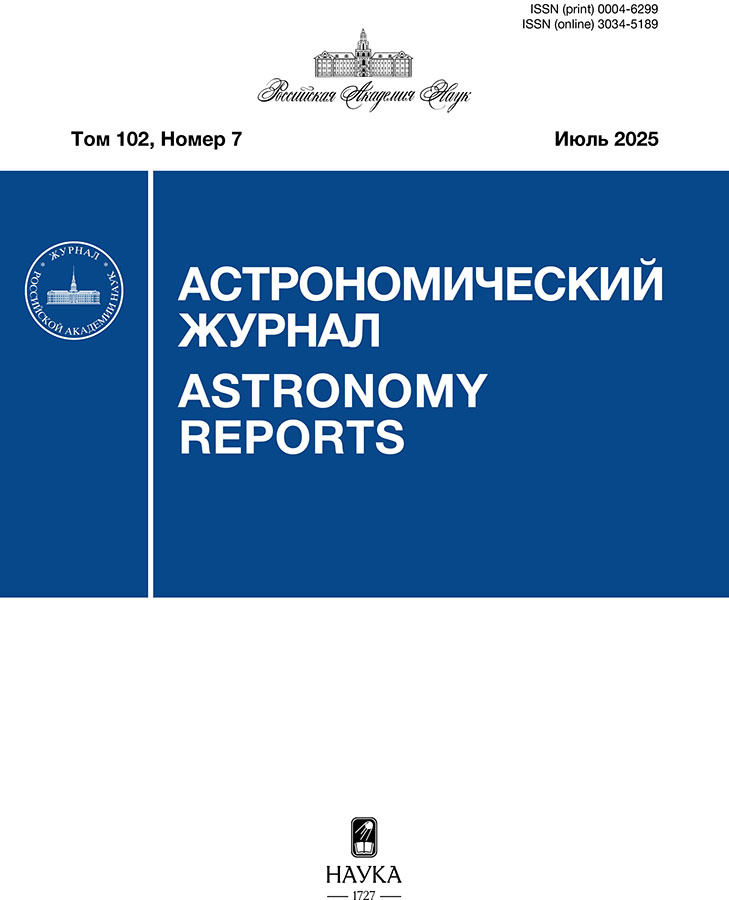Kinematics of stars with radially elongated orbits located within 100 pc from the sun
- Authors: Postnikova E.S.1, Chupina N.V.1, Vereshchagin S.V.1
-
Affiliations:
- Institute of Astronomy of the Russian Academy of Sciences
- Issue: Vol 102, No 7 (2025)
- Pages: 578-584
- Section: Articles
- URL: https://rjeid.com/0004-6299/article/view/690641
- DOI: https://doi.org/10.31857/S0004629925070047
- EDN: https://elibrary.ru/qbxjzl
- ID: 690641
Cite item
Abstract
Using numerical modeling, we studied the motion of stars whose spatial velocities have radial directions of motion in the galactic disk. For this purpose, stars located within 100 pc from the Sun with spatial velocities directed approximately to the galactic Center (or anticenter) were selected from the Gaia DR3 catalog. The sample included 13 stars with characteristics of halo stars: the eccentricities of their spatial orbits are close to unity and metallicity is significantly less than zero. An axisymmetric model of the Galaxy, including the bulge, disk, and halo, was used. It was found that the orbital apsides of the stars in our sample show a retrogradely directed precession with a velocity of 15–20 pc/million years in the interval from 10 to 20 kpc from the CG.
Keywords
About the authors
E. S. Postnikova
Institute of Astronomy of the Russian Academy of Sciences
Email: svvs@ya.ru
Moscow, Russia
N. V. Chupina
Institute of Astronomy of the Russian Academy of Sciences
Email: svvs@ya.ru
Moscow, Russia
S. V. Vereshchagin
Institute of Astronomy of the Russian Academy of Sciences
Author for correspondence.
Email: svvs@ya.ru
Moscow, Russia
References
- N.D. Utkin, A.K. Dambis, A.S. Rastorguev, A.D. Klinchev, I. Ablimit, and G. Zhao, Astron. Lett. 44, 688 (2018).
- H. Tian, C. Liu, Y. Xu, and X. Xue, Astrophys. J. 871, 184, 1805.08326 (2019).
- G. Iorio and V. Belokurov, Monthly Not. Roy. Astron. Soc. 502, 5686, 2008.02280 (2021).
- D. Carollo, T.C. Beers, Y.S. Lee, M. Chiba, et al., Nature 450, 1020, 0706.3005 (2007).
- G. Liu, Y. Huang, S.A. Bird, H. Zhang, et al., Monthly Not. Roy. Astron. Soc. 517, 2787, 2209.07885 (2022).
- Р.В. Ткаченко, А.П. Брындина, А.Б. Жмайлова, В.И. Корчагин, Астрон. журн., 2024, в печати.
- N. Tahir, F. De Paolis, A. Qadir, A.A. Nucita, Achille Symmetry 15, 1, id. 160 (2023).
- Gaia Collaboration; Smart, R. L. et al. Gaia Early Data Release 3. The Gaia Catalogue of Nearby Stars Astronomy & Astrophysics 649, id. A6, 44 (2021), https://vizier.cds.unistra.fr/viz-bin/VizieR-3?-source=J/A%2bA/649/A6/table1c Gaia Catalogue of Nearby Stars — GCNS (Gaia collaboration, 2021).
- R. Schönrich, J. Binney, W. Dehnen, Monthly Not. Roy. Astron. Soc. 403, 1829 (2010).
- M. Miyamoto, R. Nagai, Publ. Astron. Soc. Japan 27, 533 (1975).
- J.F. Navarro, C.S. Frenk, S. D.M. White, Monthly Not. Roy. Astron. Soc. 275, 56 (1995).
- R. Abuter, et al. Astron. and Astrophys. 657, id. L12 (2022).
- M.J. Reid & A. Brunthaler, Astrophys. J. 892, 1, id. 39 (2020).
- A.C. Robin, O. Bienaymé, J.B. Salomon et al., Astron. and Astrophys. 667, 98 (2022).
- J. Bovy, Astrophys. J. Supl. Ser. 216, 29 (2015).
Supplementary files










